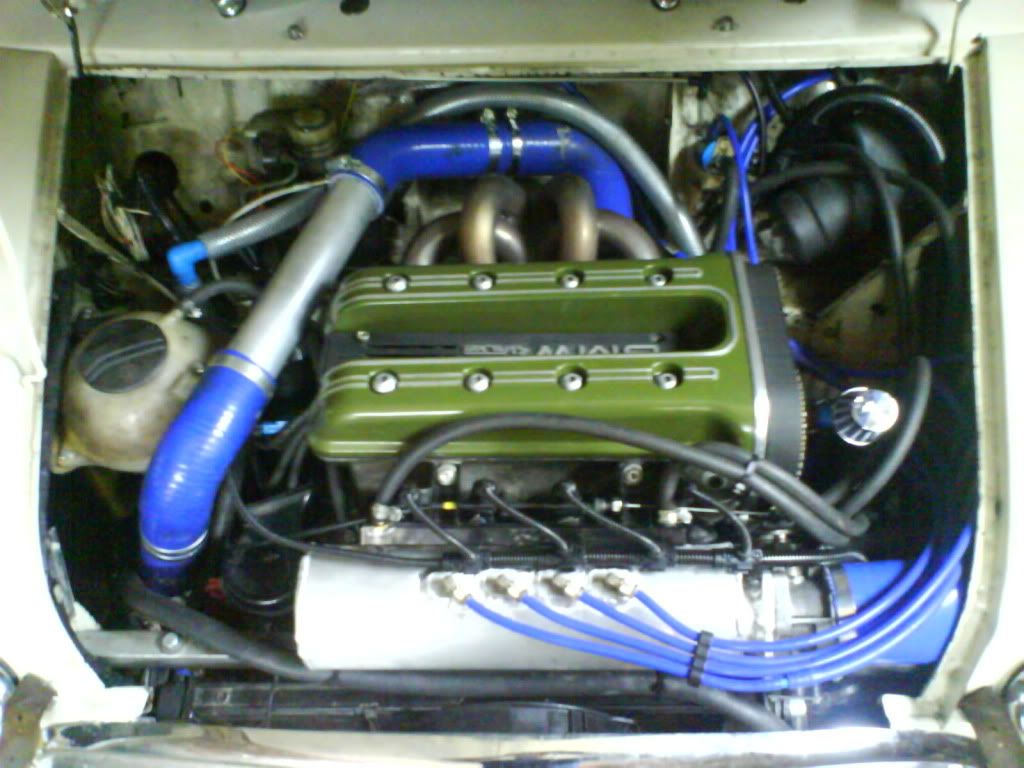| Page: |
| Home > Show Us Yours! > Electric waterpump project | |||||||
|
224 Posts Member #: 9987 Senior Member Amsterdam |
24th Oct, 2013 at 08:59:45am
Wow, this thread has exploded! Edited by Evoderby on 24th Oct, 2013. |
||||||
|
8604 Posts Member #: 573 Formerly Axel Podland |
24th Oct, 2013 at 09:35:50am
Good effort.
Saul Bellow - "A great deal of intelligence can be invested in ignorance when the need for illusion is deep."
|
||||||
 16540 Posts Member #: 4241 King Gaycharger, butt plug dealer, Sheldon Cooper and a BAC but generally a niceish fella if you dont mind a northerner Rotherham, South Yorkshire |
24th Oct, 2013 at 10:00:37am
Nice to see some thought/science behind the idea, rather than 'it'll be shit'.
On 11th Feb, 2015 robert said:
i tried putting soap on it , and heating it to brown , then slathered my new lube on it 
|
||||||
 3673 Posts Member #: 9300 Post Whore Quarry Bonk |
24th Oct, 2013 at 12:28:38pm
For me personally I wouldn't be doing it for power gains, I'd be doing more for control of the coolant flow and engine temperatures, especially important when boost and detonation is concerned. Up until a point I was gonna stick with a decent side mounted rad, but having seen so many ways of having the cooling system I haven't finalised anything yet. Although having a clubman fg front with no inner wings gives me more freedom to place things than a steel roundnose for example. I quite look forward to seeing the results, It would be nice to be able to see the before and after effects of the temperature in different locations around the engine too, especially around 4 with and without the dry deck. On 26th Jan, 2012 Tom Fenton said:
ring problems are down to wear or abuse but although annoying it isn't a show stopper On 5th Aug, 2014 madmk1 said:
Shit the bed! I had snapped the end of my shaft off!! 17.213 @ 71mph, 64bhp n/a (Old Engine) |
||||||
|
3006 Posts Member #: 2500 Post Whore Buckinghamshire |
24th Oct, 2013 at 02:13:39pm
If nothing else, getting rid of the mechanical fan makes it quieter.
|
||||||
|
Forum Mod  5933 Posts Member #: 784 9 times Avon Park Class C winner Milton Keynes |
24th Oct, 2013 at 04:23:03pm
From my own back to back testing with mechanical pump and fan vs a similar install as you there was only 4hp difference. This is on a far more powerful engine than yours so (and I stand to be corrected) Im guessing your lower powered engine will not be able to take advantage of the lesser friction and drag as mine therefore giving less power gain.
I seriously doubt it! |
||||||
|
8604 Posts Member #: 573 Formerly Axel Podland |
25th Oct, 2013 at 11:30:57am
The more I think about this, the more it interests me.
Saul Bellow - "A great deal of intelligence can be invested in ignorance when the need for illusion is deep."
|
||||||
 4890 Posts Member #: 1775 Post Whore Chester |
25th Oct, 2013 at 08:06:04pm
I tried the car without the mech fan, and it wouldn't keep cool at speed which isn't what you would expect when reading up.
I run a supercharger and I don't care the TB is on the wrong side.
|
||||||
|
224 Posts Member #: 9987 Senior Member Amsterdam |
25th Oct, 2013 at 08:15:39pm
Thanks for your indepth input Paul! -BTW I already corrected the 2^3=8 in my initial post On 24th Oct, 2013 Paul S said:
Good effort. The amount of heat that the engine needs to lose to maintain a safe operating temperature is directly related to the output power at the flywheel. So, assuming a flat torque curve for now, if you are revving to 8000rpm you need to lose twice the heat that you were at 4000rpm. Now, we know that torque curves are not flat so the ratio is probably around 3:1. A centrifugal pump characteristic changes with speed in so much that the flow increases with speed, but the head goes up with the square of the speed. That's why the power goes up in a cubic ratio. By the way, 2^3 = 8. So doubling the speed of the pump will increase the power required to drive it by 8 times. BUT, due to characteristics of the pump and system, you will get less than twice the flow at 8000rpm when you actually need more than that. I believe that the mechanical pump is the best solution, but you are correct is saying that you can show on a dyno that a power saving is available by using an electric pump. However, the power to drive the electric pump then has to come from somewhere. If it has to come from the alternator then it's just a matter of comparing the efficiencies of the power source, drive and pump. That's another subject altogether. I think you take on the "old school" sleeve is incorrect. A restriction will not influence upstream flow at all. The sleeve is used to increase pressure at the cylinder head to prevent localised boiling of the coolant. Edited by Evoderby on 25th Oct, 2013. |
||||||
|
224 Posts Member #: 9987 Senior Member Amsterdam |
25th Oct, 2013 at 08:43:46pm
On 24th Oct, 2013 paul wiginton said:
From my own back to back testing with mechanical pump and fan vs a similar install as you there was only 4hp difference. This is on a far more powerful engine than yours so (and I stand to be corrected) Im guessing your lower powered engine will not be able to take advantage of the lesser friction and drag as mine therefore giving less power gain. Tbh, I dont really believe much of what KAD have told me over the years Paul, with all due respect this has nothing to do with "far more powerful engines etc." It only has to do with water pump and fan RPM...nothing more, nothing less. I guess your engine uses a circa 310 deg cam with max power in the upper half of 7000 RPM?? In that case a 4 HP difference is very little indeed, could you perhaps share some background on testing protocol ( engine dyno vs.rollers, same day vs.different day, same testing facility, correction factors etc...) Anyway, my mini is bigger than yours 
|
||||||
|
224 Posts Member #: 9987 Senior Member Amsterdam |
25th Oct, 2013 at 08:49:22pm
On 25th Oct, 2013 gr4h4m said:
I tried the car without the mech fan, and it wouldn't keep cool at speed which isn't what you would expect when reading up. I showed a 2 hp increase but the reading wasn't on the same day. I put the mech 2 blade fan back on Hmmmm, indeed not as expected. Rest assured, if my setup proves to not perform I'll report the honest truth.... |
||||||
 8297 Posts Member #: 408 Turbo Love Palace Fool Aylesbury |
25th Oct, 2013 at 09:19:55pm
You'll be fine using that pump for cooling, i drove for a steady 110mph for about 4 hours (on a nice straight track) :) and it didn't go above 85 degrees. That was using the same pump, chinquecento rad and an 80 degree Shuttle type thermostat. Couldn't comment on power losses, it definitely takes a fair amount of current to run, but to keep the engine at a steady running temp is worth more in my eyes than power gains. https://www.facebook.com/pages/Fusion-Fabri..._homepage_panel
|
||||||
|
Forum Mod  5933 Posts Member #: 784 9 times Avon Park Class C winner Milton Keynes |
25th Oct, 2013 at 10:02:18pm
The power and what makes the power is irrelevant - just trying to say that while its a worthwhile thing to do, it wont make as much difference as you are hoping. Im not trying to piss on your bonfire - just pointing out my experience that the power gain is little and I believe that its not a case that it will be the same for every engine, I think it will be less of an advantage on a lower powered engine because its not a case of gaining power but claiming back lost power - if you can understand that, Im not very good at explaining myself and rereading my previous post it may have seemed a little abrupt.
Edited by paul wiginton on 25th Oct, 2013. I seriously doubt it! |
||||||
|
224 Posts Member #: 9987 Senior Member Amsterdam |
26th Oct, 2013 at 07:58:20am
Paul, as said before I appreciate all comments....positive or negative.
|
||||||
 690 Posts Member #: 1851 Post Whore Woolavington, Zummerzet |
26th Oct, 2013 at 10:28:56am
If my tired brian is working right, is the cooling system on a Mini/A-Series not a pump assisted thermos-syphon system ?
Metric is for people who can't do fractions. |
||||||
|
8604 Posts Member #: 573 Formerly Axel Podland |
26th Oct, 2013 at 11:24:55am
The other thing to consider is the NPSH (Net Positive Suction Head) requirements at the pump.
Saul Bellow - "A great deal of intelligence can be invested in ignorance when the need for illusion is deep."
|
||||||
 3673 Posts Member #: 9300 Post Whore Quarry Bonk |
26th Oct, 2013 at 11:37:55am
Whenever buying a water pump, I've always opted for the large impeller type, not sure if it helps or not with water flow. On 26th Jan, 2012 Tom Fenton said:
ring problems are down to wear or abuse but although annoying it isn't a show stopper On 5th Aug, 2014 madmk1 said:
Shit the bed! I had snapped the end of my shaft off!! 17.213 @ 71mph, 64bhp n/a (Old Engine) |
||||||
 690 Posts Member #: 1851 Post Whore Woolavington, Zummerzet |
27th Oct, 2013 at 07:40:20pm
Paul, I think you've expressed what i was getting at a bit better than I did.
Metric is for people who can't do fractions. |
||||||
 178 Posts Member #: 10196 Advanced Member |
27th Oct, 2013 at 08:39:05pm
I think the gains may be more due to the removal of the mechanical fan, but I doubt a 10bhp gain can be made on a 998 from it, maybe a high revving engine |
||||||
|
Site Admin  9407 Posts Member #: 58 455bhp per ton 12 sec 1/4 mile road legal mini Sunny Bridgend, South Wales |
27th Oct, 2013 at 08:57:17pm
There must be an optimum flow rate that water passes through the engine for optimal cooling. As surely too fast and the water will not have time to absorb the heat from the block. Same really with the speed of water through the radiator. Does anyone know what speed this is? On 15th May, 2009 TurboDave said:
I think the welsh one has it right! 1st to provide running proof of turbo twinkie in a car and first to run a 1/4 in one!! Is your data backed up?? one extra month free for all Turbo minis members, PM me for detials |
||||||
 2054 Posts Member #: 452 Post Whore Chester, UK |
28th Oct, 2013 at 08:27:11am
On 27th Oct, 2013 Jimster said:
There must be an optimum flow rate that water passes through the engine for optimal cooling. As surely too fast and the water will not have time to absorb the heat from the block. Same really with the speed of water through the radiator. Does anyone know what speed this is? havent people tried working this out before when buying a electric pump and what flow rate to get etc? |
||||||
 690 Posts Member #: 1851 Post Whore Woolavington, Zummerzet |
28th Oct, 2013 at 09:03:14am
The controller I bought with my pump varies the speed according to demand - engine too cold slows the pump, rising temp speeds it up - and acts as the thermostat.
Metric is for people who can't do fractions. |
||||||
 12307 Posts Member #: 565 Carlos Fandango Burnham-on-Crouch, Essex |
28th Oct, 2013 at 10:49:21am
I'm positive this is a fallacy,
On 27th Oct, 2013 Jimster said:
There must be an optimum flow rate that water passes through the engine for optimal cooling. As surely too fast and the water will not have time to absorb the heat from the block. Same really with the speed of water through the radiator. Does anyone know what speed this is? On 28th Aug, 2011 Kean said:
At the risk of being sigged... Joe, do you have a photo of your tool? http://www.turbominis.co.uk/forums/index.p...9064&lastpost=1 https://joe1977.imgbb.com/ |
||||||
|
224 Posts Member #: 9987 Senior Member Amsterdam |
28th Oct, 2013 at 01:23:58pm
Joe, this is indeed the relevant equation. The delta T part is the element least intuitive to comprehend I find:
|
||||||
|
8604 Posts Member #: 573 Formerly Axel Podland |
28th Oct, 2013 at 01:57:43pm
I can help with the heat load:
Edited by Paul S on 28th Oct, 2013. Saul Bellow - "A great deal of intelligence can be invested in ignorance when the need for illusion is deep."
|
||||||
| Home > Show Us Yours! > Electric waterpump project | |||||||
|
|||||||
| Page: |


